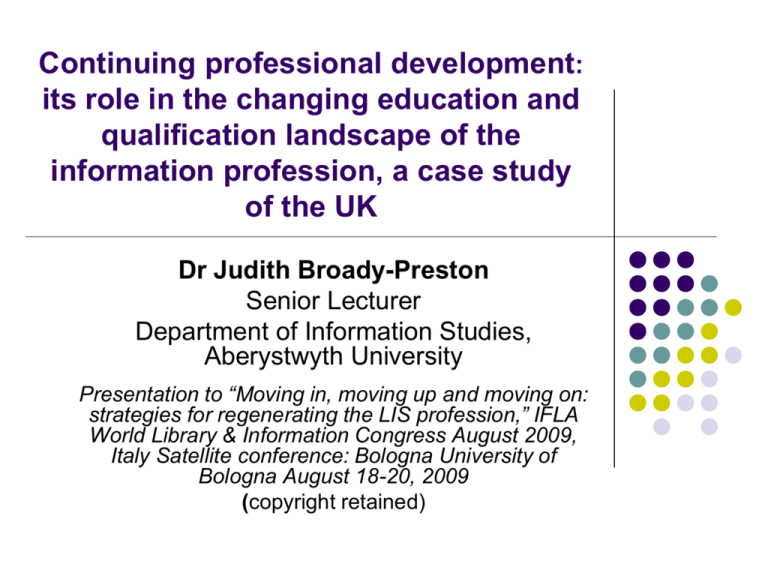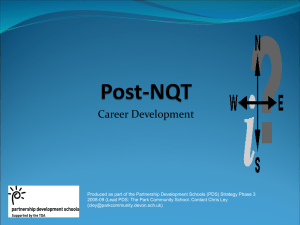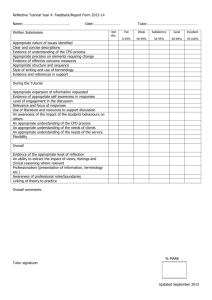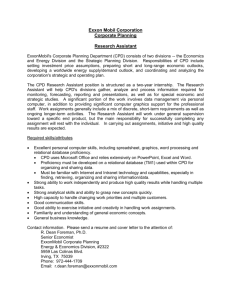Changing information behaviour: education research and
advertisement

Continuing professional development: its role in the changing education and qualification landscape of the information profession, a case study of the UK Dr Judith Broady-Preston Senior Lecturer Department of Information Studies, Aberystwyth University Presentation to “Moving in, moving up and moving on: strategies for regenerating the LIS profession,” IFLA World Library & Information Congress August 2009, Italy Satellite conference: Bologna University of Bologna August 18-20, 2009 (copyright retained) Background July 2008 - Governing Council of the UK Chartered Institute of Library and Information Professionals (CILIP) voted unanimously to introduce mandatory Continuing Professional Development (CPD) for active chartered members. CILIP = leading UK professional body for librarians, information specialists and knowledge managers, with an active professional community of c. 36, 000 of whom c. 21,000 are members. CILIP formed 1 April 2002 from the merger of the UK Library Association (LA) and the Institute of Information Scientists (IIS). “potentially far-reaching”? NB Only KNOWN mandatory scheme CILIP CPD Scheme (August 2009) “ light touch” BUT compulsory Key features: No core curriculum or minimum time requirements Emphasis on simplicity; the scheme will be web-enabled to minimize effort and inconvenience and should require little extra work beyond the CPD most would choose to do It should be able to be mapped closely onto employers’ appraisal schemes No requirement for the compilation of a portfolio Timescale for introductions yet to be determined – probable start date = January 2011 Outline Brief background to the research Introduction of mandatory CPD by CILIP UK Changing professional landscape CPD and the information profession Scope and methods Definitions and terms Cui bono? Individual vs employer benefit? Workplace learning and reflective practice Education and training implications Where are we now? Changing professional landscape “Blurring (or demolishing?) boundaries” Generic – UK Government Panel on Fair Access to the Professions – July 2009 report Information Profession – Impact web2.0, 3.0, 4.0 on sector boundaries Levels of practice – glass ceiling shatters? Governmental drivers Employability: Relationship HEIs and employers Transferability (e.g. Bologna) Recognition work-based learning – development of competency frameworks and occupational standards Emphasis on skills –’can do’ Aberystwyth Project Project aim to assess and explore the implications of the adoption of compulsory CPD schemes by professional associations within the context of the changing education and qualifications landscape for the information profession. UK = unique? Australian Library and Information Association (ALIA) = voluntary Professional Development (PD) scheme - BUT “once registered there are a number of requirements that must be met. This is compliance” (ALIA, 2009) Methodology and scope Single Case study Self-completion questionnaires to key stakeholders in CILIP decision. Response rate = 100% Chair, CILIP Task and Finish Group, Framework of Qualifications and Accreditation (TFG, FOQA) (I1) Head, Qualifications and Professional Development (QPD) CILIP (I2) Chair, CILIP Chartership Board (I3) Chair, CILIP Accreditation Board (I4) Why qualitative research (QR) methods? “[QR is] A process of enquiry that draws data from the context in which events occur, in an attempt to describe these occurrences, as a means of determining the process in which events are embedded and the perspectives of those participating in the events, using induction to derive possible explanations based on observed phenomena” (Gorman, G.E. & Clayton, P. 2005,3) What is CPD? Context Relationship cognate terms – e.g. workplace learning, reflective learning, Personal Development Plans (PDP), Human Resource Development (HRD) etc. Difficult to define – buzzword! General definitions: a combination of approaches, ideas and techniques that will help you manage your own learning and growth (CIPD, 2009) describes a commitment to structured skills enhancement and personal or professional competence (CPD Certification Service, 2009) CPD definitions: information context ALIA – NB PD not CPD: American Library Association (ALA): Through continuing professional development, the individual can effect their personal growth, and through that impact their workplace and society (2000). CILIP: Participation in an activity which will enhance and/or increase our knowledge, skills and abilities in relation to our work… (2009) No definition at present! CPD vs CPE (Continuing Professional Education) Synonyms? (cf Robinson and Glosiene, 2007) Broader and narrower terms (cf Ritchie, 2005) CPD definitions: CILIP Stakeholders it’s a realisation of the importance of learning about (and integrating where relevant) new developments, practices, skills into your own on-going professional practice in order to make better choices and more informed decisions and access more opportunities than a narrower or ageing skills-base would allow. CPD is an enabler of choice for individuals and a measure of competence, commitment and flexibility to employers. Information professionals, of all professions, need to be curious about the world. (I1) a career long active commitment to updating and extending professional knowledge, skills and competences through a range of formal and informal learning activities, which benefits the individual, employing organisations and wider society. (I2) Planned improvement of professional knowledge and skills throughout your working life. (I3) any activity – courses, conferences, reading or work-related – of which the purpose is seen by the participant as updating or increasing his or her professional knowledge.(I4) CPD: individual perspective Individual = “prime responsibility” for career development/planning Changing emphasis from ‘job for life’ to ‘joint responsibility’ for career management (individual and employer) Role of Personal Development Plans (PDPs) Mandatory provision in UK HE sector for all students (2005/6-) PDP = “a structured and supported process undertaken by an individual to reflect upon their own learning performance and/or achievement and to plan for their personal, educational and career development” (Higher Education Academy (HEA), 2002) Portfolio-based + increasingly e-based – Aberystwyth “wiki-pdp” ; JISC projects PDP, CPD and ICT HEA = explicit link PDP in education and CPD in the workplace CILIP scheme: Recognition PDP/CPD link – scheme for new professionals in first instance as they “will be used to a similar process if they are recent university graduates.” Web-enabled to minimise effort/inconvenience ICT Platform = central to success/failure of scheme 2 respondents ranked ICT platform as most significant risk -” members need to be assured that the scheme…will have effective/accessible ICT to support it (I2)” Need to ensure data security, confidentiality and privacy Individual vs employer benefit: potential conflict? CPD = fusion personal growth and professional development. Is there a conflict between individual and employer perspective? CIPD Research concluded: Individuals want employability, and for knowledge workers this means having up-to-date skills that make them desirable to employers. But bosses want to retain talent and to offer development and career progression that ties people to a career with their organisation. Many employers are wary of offering development that may make people too attractive to the competition… Employers want to develop organisation-specific skills and the individual has a desire for transferable knowledge. Individual vs employer benefit: information context Information/library context NZ study (Cossham & Fields, 2007): Balancing a library’s needs with individuals’ needs = complicated process Needs as perceived by individuals vary from those perceived by their managers overall lack of understanding across the profession about who should be responsible for what aspects of CPD, what should be offered, and who should be taking the initiative. CILIP view (CPD Framework, 2004): Effective partnership = essential if “overlapping aims improved performance and individual career enhancement are to be met.” Individual vs employer benefit: CILIP stakeholder views DIFFICULTIES RISKS Failing to convince employers of necessity for, and value of, up to date professional qualification Members whose employers have similar performance appraisal systems will not want to repeat the process REQUIREMENTS in achieving balance, especially where “employers are not convinced of the need for CPD, or believe it should be wholly focused on the tasks of the current post” (I4) Ensure mandatory scheme = “fully compatible with employers own inhouse training and appraisal schemes”(I2) ERGO – robust employer engagement strategy = necessity Workplace learning and reflective practice CPD = linked to employability Context – trends in workplace and reflective learning [NB too wide to be reviewed in depth here], BUT: Workplace learning = important contribution to improving quality and raising professional practice standards (Ritchie, 2005) Governmental drivers/initiatives re: education, employability and workforce development Boundaries “blurring” between formal and informal learning – recognition and reward of competency based practice – e.g. ACLIP Threat of generic competency-based frameworks? Possible obsolescence “qualifications” + “professions”? (Edwards) Mandatory CPD and workplace learning/reflective practice: CILIP stakeholder views PLUS points: Guarantees commitment to continuous learning – a “qualification... not ‘set in time’, but a dynamic on-going commitment to further developing professional practice” (I1) Raises profile of practitioners with employers Persuades employers and public that “information isn’t something “anyone can do” (I4)”; AND “It’s a means of helping negate all the old unhelpful ideas of ‘anyone can do it’. They can’t, not without a lot of knowledge and skill, and that knowledge and skill needs kept up-to-date. That’s a good message to get across.(I1)” NB Self-regulatory profession, therefore - centrality of robust employer engagement strategy Education and training implications Stronger focus on CPD results in: Demands for individuals to supply evidence of periodic formal study (courses, workshops etc.) – portfolio-based Results in - growth in providers of education and training, including HEIs, professional bodies themselves and other newly established education and training providers Trend towards professional bodies recognising and accrediting certain education/training providers via formalised schemes formal accreditation of university-level courses CILIP Seal of Recognition ERGO - Successful mandatory CPD schemes require approved and relevant education and training NB Role of mentors – “socialising” individuals into the profession? Where are we now? SUCCESS requires: Member buy-in – ‘light touch’ imperative + affordability Sophisticated, accessible, safe ICT platform Well developed mentor scheme Employer buy-in + robust employer engagement strategy RISKS are: “members will walk away rather than comply(I2)” ICT platform unaffordable or unworkable Lack of suitable mentors Employers prefer generic competency-based frameworks; fail to engage Conclusion Too early to assess – pilot phase yet to begin BUT – mandatory CPD offers the profession opportunities to Demonstrate equivalency with other professions Market ourselves positively as highly trained and motivated professionals Ensure recognition of the value of professional qualifications + training in a volatile environment Finally… Hopefully a starting point for further discussion/debate Thank-you for listening – happy to answer questions either now or in the future Contact – jbp@aber.ac.uk






